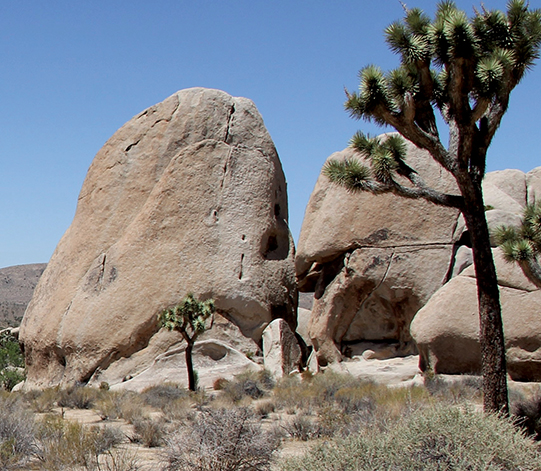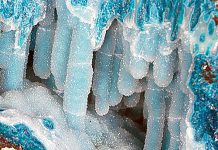
By Jim Brace-Thompson
Joshua Tree National Park in California’s Mojave Desert is a geological playground filled with odd granite formations. One consists of rounded nook-like bowls in the edges of boulders and cliffs. “What caused that?” asked my sister-in-law Mary. I assumed they were cavities carved by wind-blown sand. Fortunately, a book at the Visitor Center provided a better explanation.
D. D. Trent and Richard Hazlett’s “Joshua Tree National Park Geology” informed us that such a nook is called a “tafoni.” Just like me, geologists originally thought it resulted from wind and sand. However, there’s a new theory. Namely, these tafoni reflect a time when the California desert was much more temperate and moist and filled with soils supporting vegetation enjoyed by Ice Age animals like giant bison and ground sloths.
Worldwide Presence
Such soils abutted granite boulders and cliffs, and the roots of plants reached within and weakened the mineral grains of the granite. Also, acids from plant decay and periodic wetting and drying dug into the rock face. Eventually, plants—both living and decaying—crafted the hollows and pits we see today now that surface soils have dried and blown away.
Tafoni can be found worldwide, from beaches on the Isle of Skye to Australia and Antarctica. Not all were crafted by vegetation. Some resulted from salt weathering, cycles of freezing and thawing, or variations in a particular rock structure. They sometimes form networks of honeycomb-like cavities across the surface of a rock face and can riddle an entire cliff. The word “tafoni” itself stems from Corsican and Sicilian words for “holes” or “windows”.
Next time your family plans a vacation in one of our national parks, see if you can find a book that will help you better appreciate the geology that you’ll see—while learning a weird word or two.
Author: Jim Brace-Thompson
 Founder and overseer of the AFMS Badge Program for kids.
Founder and overseer of the AFMS Badge Program for kids.
He’s also an inductee of the National Rockhound & Lapidary Hall of Fame within the Education Category.















